The red-headed vulture (Sarcogyps calvus), also known as the Asian king vulture or Pondicherry vulture, is a critically endangered bird native to the Indian subcontinent and parts of Southeast Asia. Recognizable by its distinctive red head and black plumage, this species has experienced a significant population decline in recent decades.
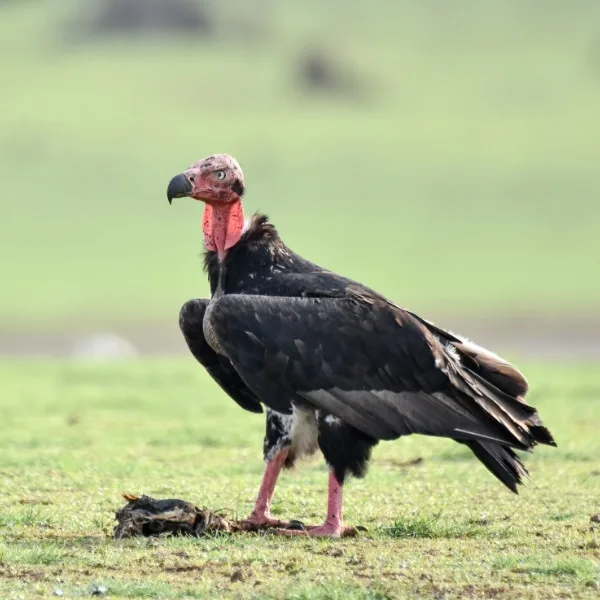
Profile
| Common name | Red-headed vulture |
| Scientific name | Sarcogyps calvus |
| Alternative names | Asian king vulture, Indian black vulture, Pondicherry vulture |
| Order | Accipitriformes |
| Family | Accipitridae |
| Genus | Sarcogyps |
| Identification | Black body, prominent red head, pale grey band at the base of flight feathers |
| Range | Indian subcontinent and parts of Southeast Asia |
| Habitat | Open country, well-wooded hills, dry deciduous forests, foothills, and river valleys |
| Diet | Carrion |
| Conservation status | Critically endangered |
Discovery
The red-headed vulture was first described by Giovanni Antonio Scopoli in 1786 and remains the sole member of the genus Sarcogyps. Unlike the more social Gyps vultures, Sarcogyps evolved as a territorial, solitary scavenger, likely filling a distinct ecological niche.
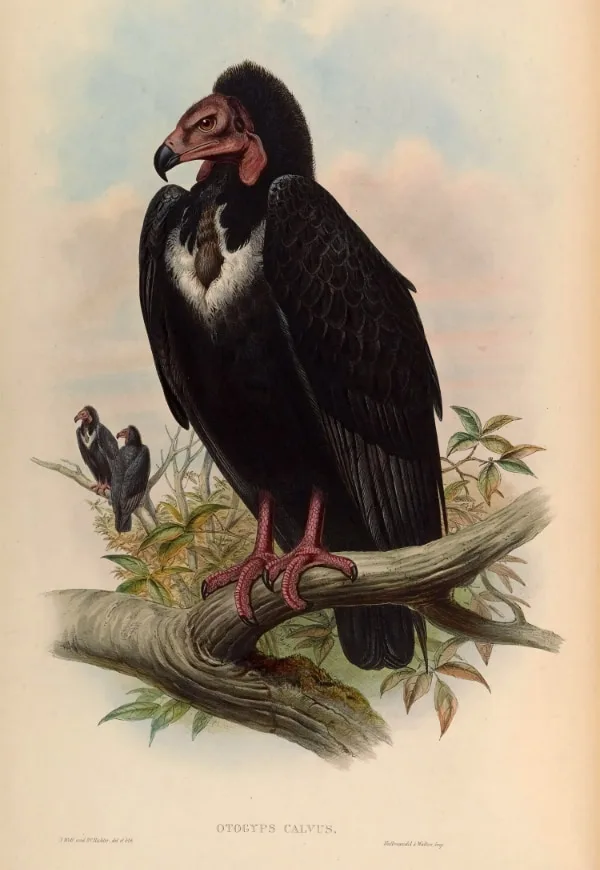
Its classification within Old World vultures (Accipitridae) has been debated. Early taxonomists suggested a close relationship with Trigonoceps (white-headed vulture) and Torgos (lappet-faced vulture) due to similarities in structure and behavior. However, more recent research places it within the broader Aegypiinae subfamily, alongside large-bodied scavenging raptors.
Historically, this species occupied a vast range across South and Southeast Asia, but its distribution has significantly declined due to habitat loss, poisoning, and food scarcity.
Note: Otogyps calvus was the former scientific name of the red-headed vulture, later reclassified as Sarcogyps calvus after taxonomic revisions placed it in a distinct genus separate from Gyps vultures.
Identification
The red-headed vulture measures between 76 to 86 cm (30 to 34 inches) in length, with a wingspan ranging from 1.99 to 2.6 meters (6.5 to 8.5 feet). Adults typically weigh between 3.5 to 6 kg (7.7 to 13.2 lbs).
They have a deep-red to orange naked head, which varies in intensity, contrasting with their black body plumage. A black ruff encircles the neck, and a distinctive white downy patch runs across the breast. The feathers are black overall, with browner shading around the crop, lower back, and rump. When the wings are extended, a white line at the base of the flight quills and two white patches above the thigh joint are visible. The cere, feet, and legs are also red.
The iris color varies, with reports of reddish-brown, yellow, or red eyes in adults. Males generally have a whitish iris, while females have darker brown irises.
Juveniles have pale brown upperparts and underparts, with dark brown to black wing and tail quills. Their head is covered with white down, and some white feathers are present on the throat and below the breast. The iris is clearly brown, and the bare skin, cere, feet, and legs are paler reddish compared to the adult.
Vocalization
The red-headed vulture is generally silent, like most vultures, as it lacks a syrinx (the vocal organ in birds). However, it is capable of producing harsh, roaring calls, particularly during courtship displays and breeding interactions. These sounds are most commonly heard when pairs engage in soaring displays, at nest sites, and during greeting ceremonies when changing incubation shifts.
Range and habitat
Historically, the red-headed vulture was widespread across the Indian subcontinent, extending eastward into south-central and southeastern Asia, from India to Singapore. In recent decades, its range has contracted significantly. Currently, the species is primarily found in northern India and Nepal, with smaller populations in Cambodia and Myanmar. It has become rare or possibly extinct in countries like Pakistan, Thailand, Laos, Vietnam, Malaysia, and Singapore.
This vulture inhabits open country, well-wooded hills, and dry deciduous forests, often near rivers. It is typically found at elevations up to 2,500 meters (8,200 feet), though it can occur up to 3,000 meters (10,000 feet).
Behavior
The red-headed vulture is a mostly solitary species, often observed alone or in breeding pairs rather than in large groups. Unlike some other vultures, it does not form communal roosts or feed in large flocks. It is known for its spectacular aerial displays, where pairs soar together at high altitudes, diving and twisting around one another. These displays serve as both courtship rituals and territorial behavior.
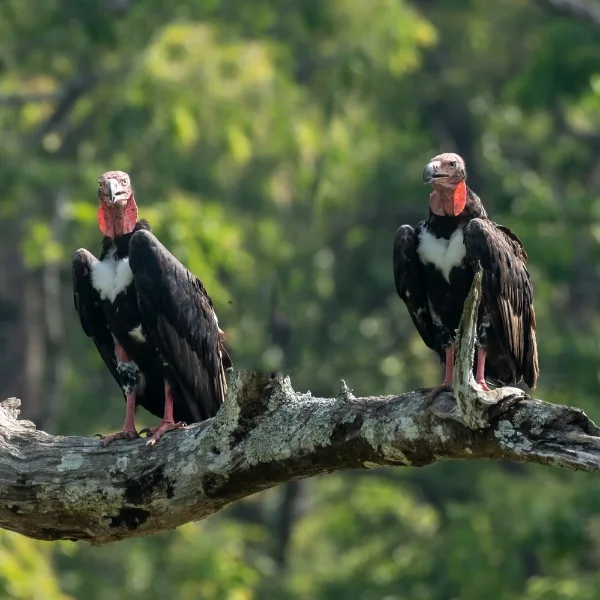
When feeding, it is highly territorial over carcasses, often defending its position from smaller vultures. However, despite its imposing appearance, it does not dominate at large carcasses and frequently gives way to larger or more aggressive species, such as the Indian white-rumped vulture (Gyps bengalensis) and Indian vulture (Gyps indicus).
It is more likely to scavenge smaller carcasses that other vultures ignore, such as rodents trapped in fields or animals killed by grass fires. Unlike more social scavengers, it often feeds quickly and withdraws, rather than lingering at a carcass.
The red-headed vulture is less inclined to approach human habitation and tends to avoid areas with high human activity, preferring more remote landscapes.
Breeding
Mating typically takes place on a tree branch near the nest, accompanied by loud roaring calls similar to those made during display flights. Nests are built in trees, positioned anywhere between 1 to 30 meters (3 to 100 feet) above the ground. In areas where large trees are unavailable, nests may be built in low bushes or Euphorbia plants. The species does not nest in colonies of its own kind, but may build its nest in the same tree as white-backed vultures.
The nest starts as a relatively small, loosely constructed platform of sticks, but since it is reused every year, it gradually grows larger, sometimes reaching 1.5 meters (5 feet) across and 1.2 meters (4 feet) deep. The structure is reinforced with leafy branches and lined with various materials, including pieces of skin, hair, and other debris. Both sexes participate in nest-building, with the male bringing materials and the female incorporating them into the nest.
A single egg is laid, broad and oval in shape, with a smooth texture, often slightly glossy, and either plain greenish-white or pure white. Both sexes take turns incubating the egg, with the female sitting through the night and early morning, while the male takes over during the day. Incubation lasts for about 45 days, and when the pair switches roles, they engage in greeting ceremonies, which involve loud roaring vocalizations.
Diet
The red-headed Vulture is a scavenger, primarily feeding on carrion and playing a crucial role in the ecosystem by disposing of animal remains. Its strong beak allows it to tear into tough carcasses, while its bald head prevents feather soiling during feeding.
It readily descends to feed on small animals killed by grass fires or rodents left in paddy fields, much like the African white-headed vulture (Trigonoceps occipitalis). It has also been observed soaring over grassland fires, waiting for opportunities to scavenge newly killed prey.
Culture
In some regions, vultures, including the red-headed vulture, have been associated with negative perceptions due to their scavenging nature. However, they hold ecological importance and have been subjects of interest in various cultural narratives.
Threats and conservation
The red-headed vulture is classified as critically endangered on the IUCN Red List, with a declining population trend. Once widespread, it is now among the world’s rarest vultures, with an estimated 2,500 to 10,000 mature individuals remaining in the wild as of 2021.
The species has suffered a rapid population decline, primarily due to feeding on carcasses of livestock treated with the veterinary drug diclofenac, which is highly toxic to vultures. Other significant threats include habitat loss, direct poisoning, and human disturbances.
Conservation efforts are ongoing. Bans on diclofenac have been implemented in India, Nepal, and Pakistan to reduce poisoning risk, while captive breeding programs have been established as part of South Asian vulture conservation initiatives.
Several regions have introduced Vulture Safe Zones (VSZs), designated areas free from diclofenac where populations can recover. Research and monitoring efforts by organizations such as BirdLife International and The Peregrine Fund continue to assess population trends and implement protective measures.
Despite these efforts, the red-headed vulture remains in critical decline. Without continued conservation measures, strict regulation of veterinary drugs, and habitat protection, this species faces an uncertain future.
Similar species
While the red-headed vulture is a unique species, it shares some characteristics with other vultures in terms of appearance, feeding behavior, and range. Four species, in particular, show notable similarities.
Lappet-faced vulture (Torgos tracheliotos)
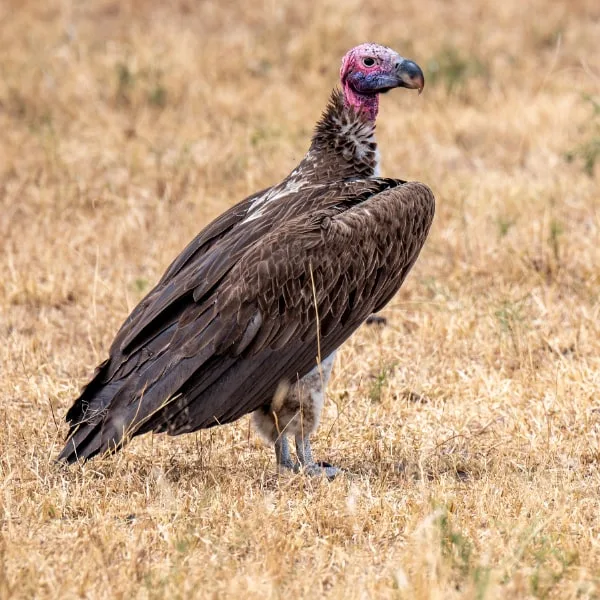
The Lappet-faced vulture is the most comparable species to the red-headed vulture. Both are large-bodied, solitary scavengers with a distinctive bare red head. However, the lappet-faced vulture is generally larger, has a broader wingspan, and is found in Africa and the Arabian Peninsula, whereas the red-headed vulture is native to South Asia. The lappet-faced vulture also has more prominent fleshy lappets on the sides of its head, a feature absent in the red-headed vulture.
White-rumped vulture (Gyps bengalensis)

The white-rumped vulture shares part of the red-headed vulture’s range in South Asia and often competes with it at carcasses. Unlike the solitary red-headed vulture, this species is more social, typically found in large colonies. It belongs to the Gyps genus, which includes vultures that primarily scavenge large animal carcasses, whereas the red-headed vulture is more likely to feed on smaller remains.
Slender-billed vulture (Gyps tenuirostris)
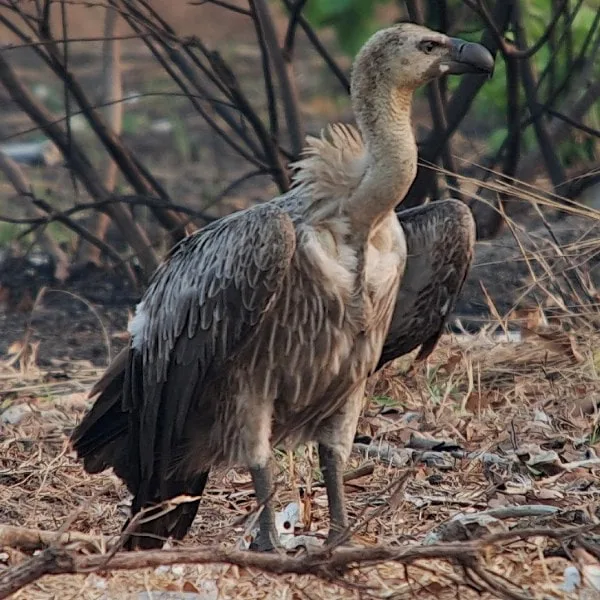
The slender-billed vulture is another species with similar range and diet. It occurs in overlapping regions of South Asia and, like the white-rumped vulture, belongs to the Gyps genus. However, unlike the red-headed vulture, it lacks a distinct red, wrinkled head and is more frequently found in groups rather than alone or in pairs.
Indian vulture (Gyps indicus)
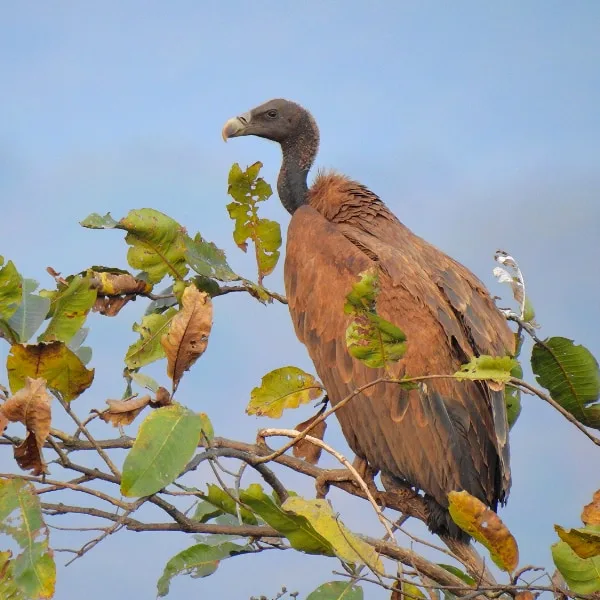
The Indian vulture also shares part of the red-headed vulture’s range and is often found in dry, open landscapes. Though not as social as the white-rumped vulture, it is less solitary than the red-headed vulture. The Indian vulture primarily feeds on larger carcasses, whereas the red-headed vulture is more opportunistic, frequently scavenging smaller remains. It also lacks the red, bare head that distinguishes the red-headed vulture.
Future outlook
Despite ongoing conservation efforts, the red-headed vulture remains critically endangered, with its population continuing to decline. Given the current challenges, it is anticipated that the species will persist in low numbers and may become increasingly dependent on human-managed feeding programs, such as “vulture restaurants”, to survive in the wild.
While habitat protection and captive breeding programs provide some hope, the long-term future of this species remains uncertain.
At Planet of Birds, we closely follow the status of vultures worldwide, monitoring their population trends and conservation efforts. These birds play a vital ecological role, and we remain hopeful that sustained conservation initiatives will help prevent further decline.
For more information on the red-headed vulture, consider exploring the following resources:
